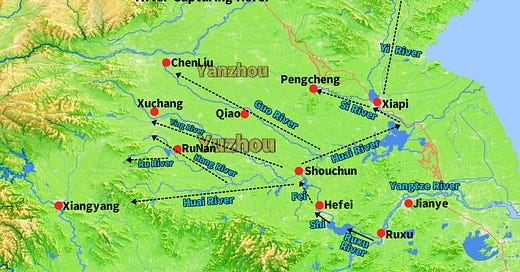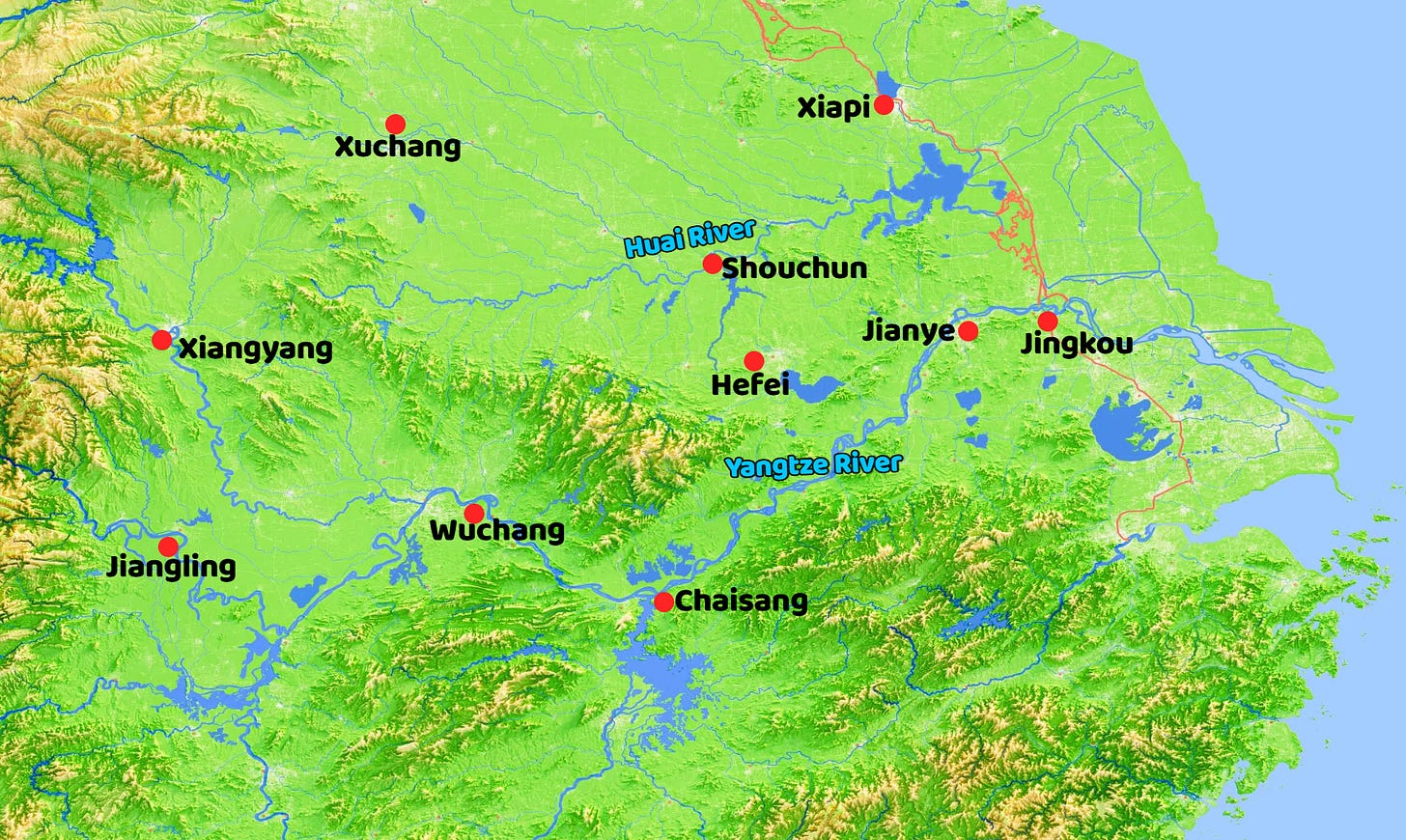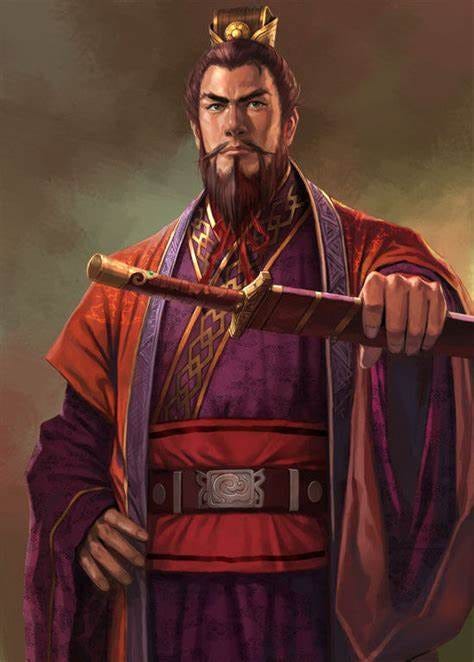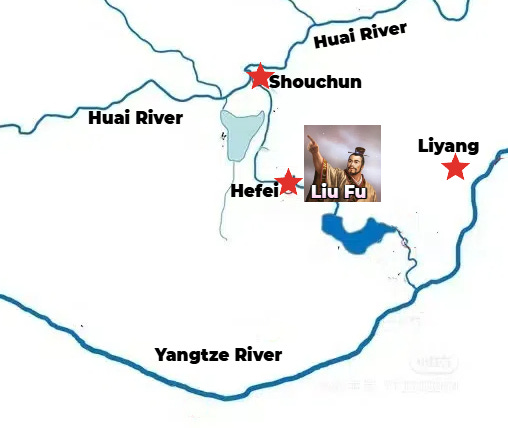Why Hefei is the Only Choice in Sun Quan's Northern Campaigns 2(Three Kingdoms 58)
If Hefei had been captured, what could Sun Quan have achieved?
Previous Chapter :Why Hefei is the Only Choice in Sun Quan's Northern Campaigns 1
Catalog of Three Kingdoms’ history
Last Chapter ,we had talked about 3 waterways for the Wu’s Army to marching into the Central Plains held by Cao Cao, but the two of them ,the Han汉 River waterway in the west and the Northern Jiangsu江苏 waterway in the east, are not reliable. The only choice is the Ruxu-Shi-Fei Rivers waterway in the middle. Let's talk about in this Chapter:
Taking the middle waterway of Ruxu-Shi-Fei Rivers, Wu's warships could enter Chao Lake巢湖 from the Yangtze River along the Ruxu濡须 River, then sail down Shi施 River, a tributary of Chao Lake, into Fei淝 River, a tributary of the Huai淮 River.
After which they could enter the Huai River from Shouchun寿春. Not only is this waterway a short trip and close to the Central Plains, but the river is wide and deep, which facilitates the navigation of large ships.
For Sun Quan's warships, as long as they entered the Huai River, it would be equivalent to a dragon swimming into the sea.
If they went eastward along the Huai River, they could go northward into the Si泗 River. The Si River runs through Xuzhou徐州 from south to north, and then Xiapi下邳, the capital of Xuzhou, will become an outpost instead of a rear area for Wei.
Xiapi is the confluence of the Si and Yi沂 rivers, and back then, Cao Cao dug up these two rivers in order to capture Lu Bu吕布 and flood the city of Xiapi.
Once Xiapi was captured, Wu's naval forces could enter Qingzhou青州 along the Yi River, basically covering all of Qingzhou.
If Sun Quan feels that Qingzhou and Xuzhou are not interesting enough, he can also visit Cao Cao's hometown Qiao谯 County and his headquarters in Yanzhou兖州 along the Guo涡 River.
If the Wu’s warships entered the Huai River and chose to go upstream, they could enter the hinterland of Yuzhou豫州 along the Hong洪 and Ru汝 rivers, and even reach the city of Xuchang许昌 along the Ying颍 River.
By relying on the well-connected river system, Sun Quan can easily complete a precise strike on more than half of the cities in the Central Plains with his navy ships, and Cao Cao will have no way of defending himself at that time.
If this comes true, I'm afraid Sun Quan will wake up laughing in his dreams.
Even if Sun Quan had no intention of forging ahead in the Central Plains, standing on passive defense, he was still very eager to push the defensive front from the Yangtze River to the Huai River coast.
At the late Han period, the southern China was actually very underdeveloped and the agriculture falls much behind the north. Therefore, the six Commanderies under Sun Quan's rule appeared to be a very large territory, but in fact, the main cities and populations were located in the narrow strip of land along the bank of the Yangtze River.
For Sun Quan, the Yangtze River is actually both the first and the last line of defense. Once the northern army succeeds in crossing the river, there will be no more strongholds to defend.
Therefore, Sun Quan's successive relocations of his capital, whether it was Wu吴 County in the early days, or Jingkou京口, Wuchang武昌, Jianye建业, afterwards ,or Chaisang柴桑 which he just occupied before the Battle of Red Cliff, they were all along the Yangtze River.
Although, Sun Quan is somehow similar to the Emperors guarding the country's Northern Gate in Beijing during the Ming Dynasty(1366-1644AD), which deserves to be recognized, I am afraid that it is rather sorrowful and helpless that Sun Quan feels.
Since the ancient times, the southern ruling regimes that could only defend the Yangtze River could not last long. Because once the northern army marching south, stationed on the north bank of the Yangtze River, when to across the river is just a matter of time, only to advance the defense line to the Huai River basin, relying on the Yangtze-Huai Plain as a buffer zone, using the layers of the dense Yangtze-Huai rivers network, build up a defense system which is attackable and defensible, easy to enter and exit from both land and water .
In order to hold a long time with the Central Plains Regime, to get rid of the destiny of the slow death, that is why there is an Ancient Chinese saying that:" To Defend the Yangtze, You Must Hold the Huai" (守江必守淮)".
The reason that a single Yangtze River can not be defended, Sun Quan understands surely;
The ambition of Unifying All Under Heaven, Sun Quan also has , at least now he sitll has;
The feeling of laughing in the dreaming, Sun Quan is also looking forward to.
But in order to enter the Huai River from the line of the Ruxu-Shi-Fei Rivers, it is necessary to pass through Hefei first!
Hefei's name, is because the Shi River and Fei River converge here, the famous "Commentary on the Water Classic"(水经注) said: " water surges in summer, Shi together with the Fei, so it is called Hefei." the word “He合”( means together in Chinese.
When Liu Fu刘馥 was sent here by Cao Cao in 200 A.D., Jiujiang九江 commandery had been spoiled by Yuan Shu and Hefei had become an empty city with no people.
However, considering the irreplaceable strategic role of Hefei, Liu Fu resolutely moved his seat of Yangzhou扬州 from Liyang历阳 to Hefei.
During the eight years from 200 to 208 AD, Liu Fu organized schools, educated the people, pacified the powerful clans, promoted the part-time farming, and attracted the people who had gone out to seek refuge to return to their hometowns, so that Jiujiang Commandery gradually regained its former prosperity.
During this period, he vigorously rebuilt the city defense of Hefei, stocked up abundant supplies for war preparation, and made Hefei an impregnable town in the north of the Yangtze River.
But for Sun Quan, the nightmares and troubles that would haunt his lifetime were quietly beginning to take shape.
To be Continued.
Your support is my greatest motivation!








